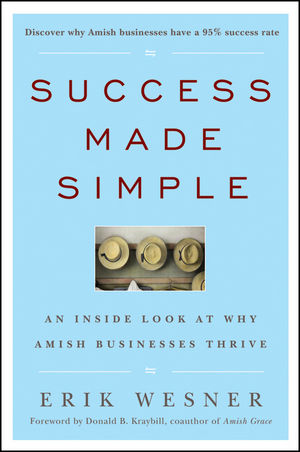
What do technology-averse, horse-carting craftspeople know about business? Quite a bit, it turns out.
The Amish, that famous religious community concentrated mostly in Pennsylvania, avoid technology and cars. They have an eighth-grade education. Yet they’ve mastered many of the business concepts it takes the rest of us years to understand.
Author Erik Wesner, who writes the excellent AmishAmerica blog, spent two years researching Amish businesses in Pennsylvania and Ohio. His new book, “Success Made Simple: An Inside Look at Why Amish Businesses Thrive” is the result.
By weaving together the Amish experience, common business knowledge, and ideas from mainstream business gurus, Wesner derives business lessons for the rest of us. As the title suggests, the Amish remind us that business doesn’t have to be a complicated venture.
What’s Inside
Here’s a general summary of what’s in each chapter:
Chapters 1 & 2: You learn about how the Amish use vision and faith to build successful firms. Next, Wesner explores how Amish people become successful with only an eighth-grade education, standard in the culture.
Chapter 3 describes the Amish approach to sales and marketing, which emphasizes relationship-building and customer service.
Chapter 4 dives more deeply into relationships and customer service. You also learn how the Amish tend their reputations and difficult clients.
Chapter 5 & 6 cover Amish approach to team-building, managing, and hiring. Many Amish people have to keep community interests at heart when hiring, firing, and motivating employees.
In Chapter 7, you learn how the Amish stay competitive. This includes how to compete in a friendly, sustainable way with others in your community—not something that’s standard in so-called English (American) culture.
Wesner wraps up the book with the Amish definition of business and success, leading readers to ponder what community, success, and their overall goals mean to them.
Thoughts on Style
When I first started reading the book, I couldn’t figure out whether Wesner was describing the Amish or imparting general business wisdom. He’d weave Amish tales, business expert quotes, and general business wisdom into the same section. After a little hesitation, however, the style grew on me. I ultimately saw it as unique and quite seamless.
If one thing about the book caught me off-guard, it was Wesner’s gentle, respectful treatment of the Amish. Chock it up to bad media conditioning. I suppose I expect business books to dictate something to me, and this one didn’t. It didn’t assume wrong or right. It was respectful. (Hey, maybe we could use more of this.)
Wesner also has a knack for illustrating how the Amish operate in their day-to-day lives. His stories, anecdotes, quotes, and research made me feel like I knew the Amish. I could tell he spent a lot of time with them.
Thoughts on Content
If you read business books, you’ve probably already learned some of Success Made Simple’s business lessons, which cover general business topics like marketing and human resources. The lessons I found most useful, however, were those I hadn’t heard before. These include how the Amish use faith as a catalyst for business motivation and success. Or how Amish treat competition when everyone’s in the same community.
I was also fascinated to learn that the Amish don’t go to court. That shines a new light on how to sift out and treat difficult customers without threatening them with legal action. These unique lessons, the ones you don’t find everywhere else, made the book stand out.
A Worthy Read
Success Made Simple is one of those books everyone can benefit from. Its mellow style and interesting anecdotes make it a good commuting or poolside companion. I especially recommend this book for business students, anyone interested in general business lessons, or anyone interested in the Amish.
Full disclosure: We received a free copy of this book.
